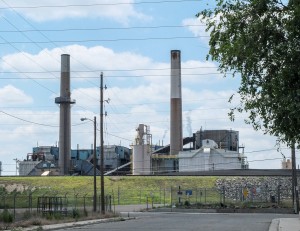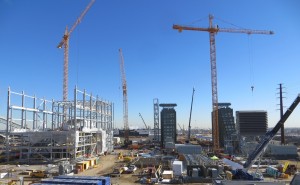Scientists report that switch to natural gas power plants means fewer air pollutants
9 January 2014
WASHINGTON, D.C. — Power plants that use natural gas and a new technology to squeeze more energy from the fuel release far less of the greenhouse gas carbon dioxide than coal-fired power plants do, according to a new analysis accepted for publication in Earth’s Future, a journal of the American Geophysical Union. The paper was first posted online Jan. 8. The so-called “combined cycle” natural gas power plants also release significantly less nitrogen oxides and sulfur dioxide, which can worsen air quality.
“Since more and more of our electricity is coming from these cleaner power plants, emissions from the power sector are lower by 20, 30, even 40 percent for some gases, since 1997,” said lead author Joost de Gouw, an atmospheric scientist with the National Oceanic and Atmospheric Administration’s (NOAA) Cooperative Institute for Research in Environmental Sciences (CIRES) at the University of Colorado Boulder.

In 2013, Xcel Energy decommissioned this coal-fired power unit in Denver’s Arapahoe Station. Shifts in the U.S. energy industry, including less electricity from coal, have meant fewer emissions of greenhouse gases and other pollutants from power plants, according to a new analysis.
Credit: NOAA
De Gouw, who works at NOAA’s Earth System Research Laboratory (ESRL), and his NOAA and CIRES colleagues analyzed data from systems that continuously monitor emissions at power plant stacks around the country. Previous aircraft-based studies have shown these stack measurements are accurate for carbon dioxide and for nitrogen oxides and sulfur dioxide. Nitrogen oxides and sulfur dioxide can react in the atmosphere to form tiny particles and ozone, which can cause respiratory disease.
To compare pollutant emissions from different types of power plants, the scientists calculated emissions per unit of energy produced, for all data available between 1997 and 2012. During that period of time, on average:
- Coal-based power plants emitted 915 grams (32 ounces) of carbon dioxide per kilowatt hour of energy produced;
- Natural gas power plants emitted 549 grams (19 ounces) carbon dioxide per kilowatt hour; and
- Combined cycle natural gas plants emitted 436 grams (15 ounces) carbon dioxide per kilowatt hour.
In combined cycle natural gas plants, operators use two heat engines in tandem to convert a higher fraction of heat into electrical energy. For context, U.S. households consumed 11,280 kilowatt hours of energy, on average, in 2011, according to the U.S. Energy Information Agency. This amounts to 11.4 metric tons per year of carbon dioxide per household, if all of that electricity were generated by a coal power plant, or 5.4 metric tons if it all came from a natural gas power plant with combined cycle technology.
The researchers reported that between 1997 and 2012, the fraction of electric energy in the United States produced from coal gradually decreased from 83 percent to 59 percent, and the fraction of energy from combined cycle natural gas plants rose from none to 34 percent.

Construction of a combined cycle natural gas plant in Denver, operated/owned by Xcel Energy, should be complete in 2014. Combined cycle natural gas plants release far less of the greenhouse gas carbon dioxide than coal-fired power plants do, scientists report.
Credit: Xcel
That shift in the energy industry meant that power plants, overall, sent 23 percent less carbon dioxide into the atmosphere last year than they would have, had coal been providing about the same fraction of electric power as in 1997, de Gouw said. The switch led to even greater reductions in the power sector’s emissions of nitrogen oxides and sulfur dioxide, which dropped by 40 percent and 44 percent, respectively.
The new findings are consistent with recent reports from the Energy Information Agency that substituting natural gas for coal in power generation helped lower power-related carbon dioxide emissions in 2012.
The authors noted that the new analysis is limited to pollutants emitted during energy production and measured at stacks. The paper did not address levels of greenhouse gases and other pollutants that leak into the atmosphere during fuel extraction, for example. To investigate the total atmospheric consequences of shifting energy use, scientists need to continue collecting data from all aspects of energy exploration, production and use, the authors concluded.
*****
Journalists and public information officers (PIOs) of educational and scientific institutions who have registered with AGU can download a PDF copy of this accepted article by clicking on this link: http://onlinelibrary.wiley.com/doi/10.1002/2014EF000196/abstract
Or, you may order a copy of the final paper by emailing your request to Nanci Bompey at [email protected]. Please provide your name, the name of your publication, and your phone number.
Neither the paper nor this press release is under embargo.
“Reduced Emissions of CO2, NOx and SO2 from U.S. Power Plants Due to the Switch from Coal to Natural Gas with Combined Cycle Technology”
Authors:
Joost de Gouw: NOAA’s Cooperative Institute for Research in Environmental Sciences, University of Colorado, Boulder, Colorado, USA;
David Parrish: NOAA Earth System Research Laboratory, Boulder, Colorado, USA;
Greg Frost: NOAA’s Cooperative Institute for Research in Environmental Sciences, University of Colorado, Boulder, Colorado, USA;
Michael Trainer: NOAA Earth System Research Laboratory, Boulder, Colorado, USA.
Contact information for the authors:
Joost de Gouw: +1 (303) 497-3878, Email: [email protected]
Nanci Bompey
+1 (202) 777-7524
[email protected]
CIRES Contact:
Katy Human, CIRES Communications
+1 (303) 735-0196
[email protected]